Principles of Project Management : Sample Assignment
VerifiedAdded on 2021/01/02
|10
|2833
|428
AI Summary
Contribute Materials
Your contribution can guide someone’s learning journey. Share your
documents today.
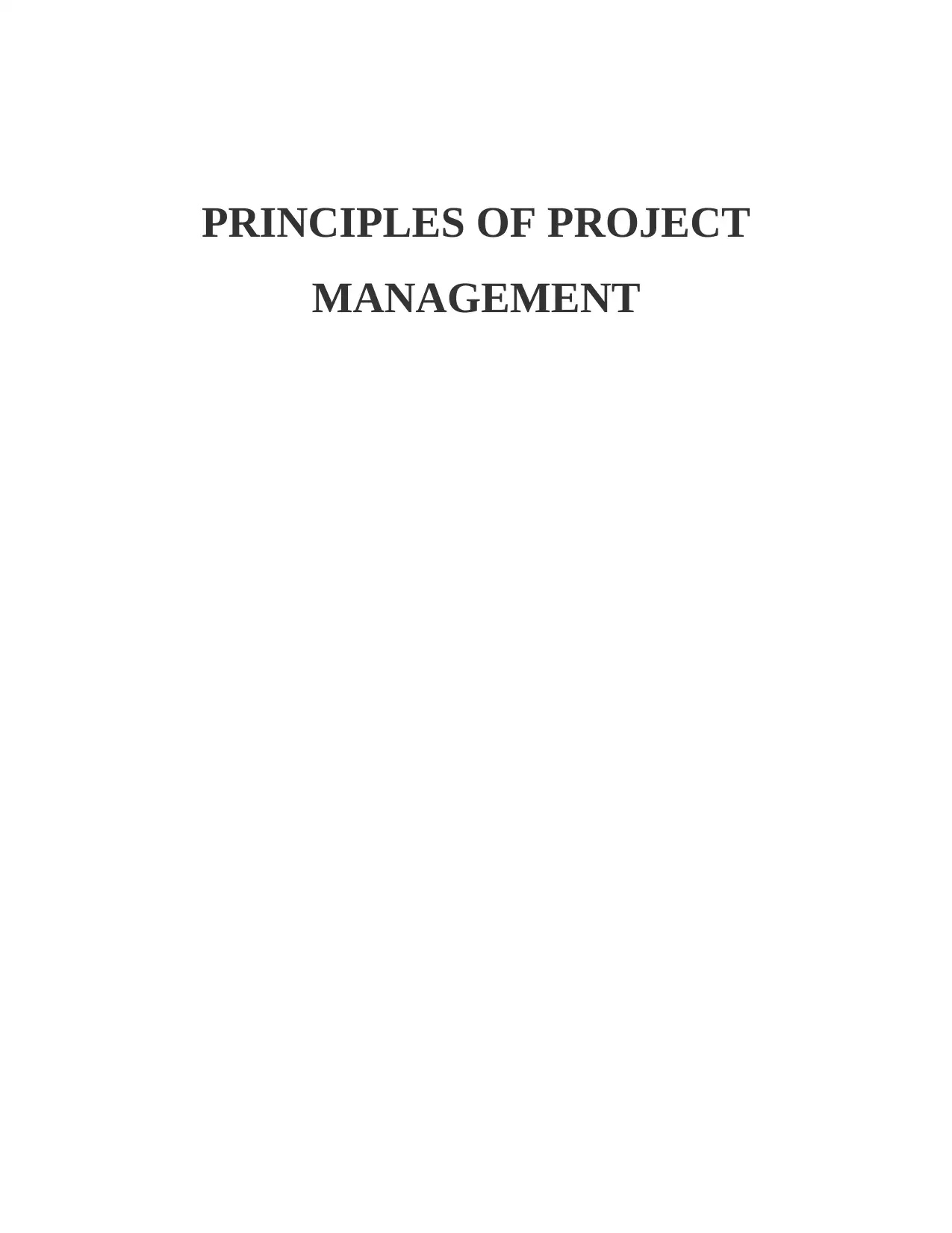
PRINCIPLES OF PROJECT
MANAGEMENT
MANAGEMENT
Secure Best Marks with AI Grader
Need help grading? Try our AI Grader for instant feedback on your assignments.
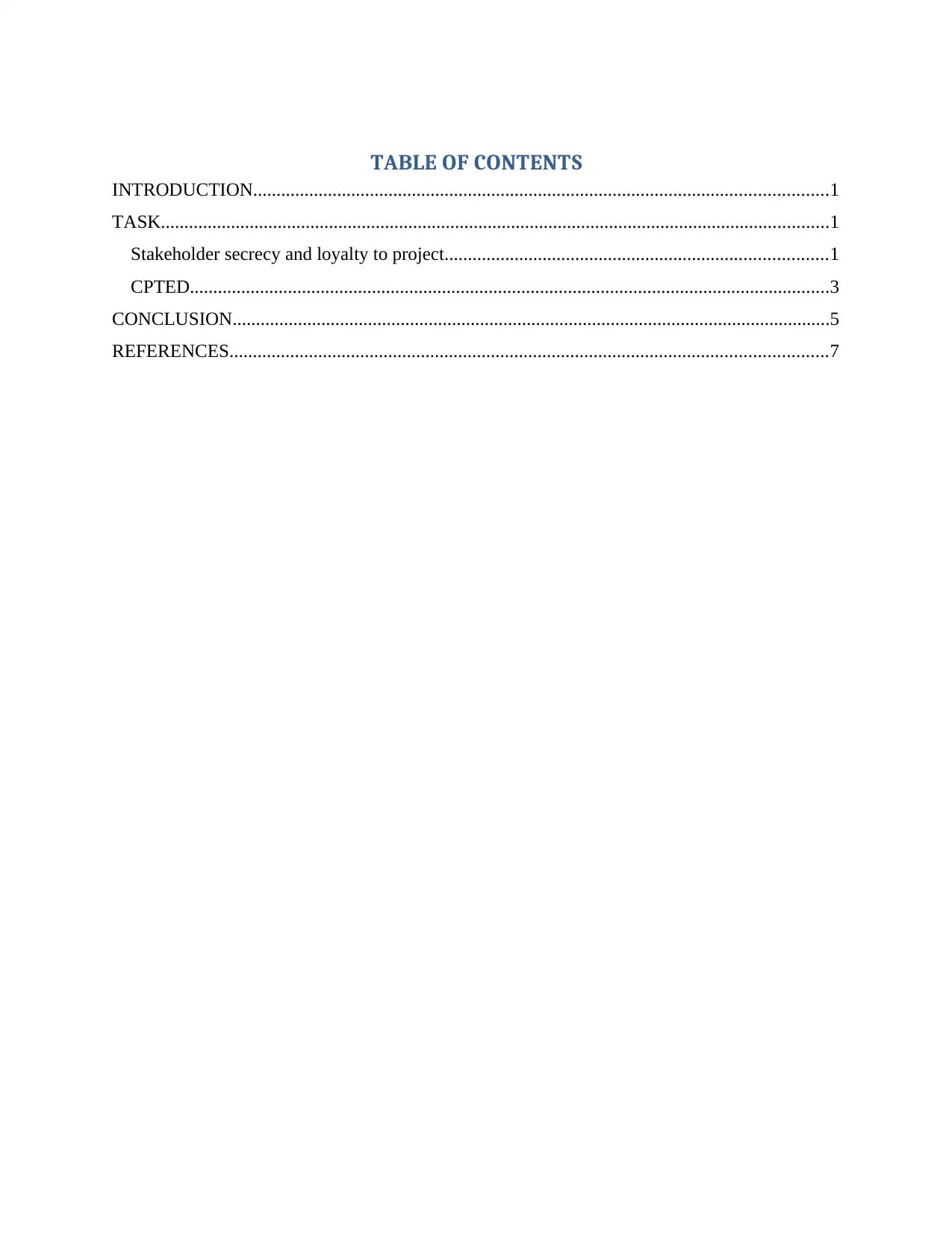
TABLE OF CONTENTS
INTRODUCTION...........................................................................................................................1
TASK...............................................................................................................................................1
Stakeholder secrecy and loyalty to project..................................................................................1
CPTED.........................................................................................................................................3
CONCLUSION................................................................................................................................5
REFERENCES................................................................................................................................7
INTRODUCTION...........................................................................................................................1
TASK...............................................................................................................................................1
Stakeholder secrecy and loyalty to project..................................................................................1
CPTED.........................................................................................................................................3
CONCLUSION................................................................................................................................5
REFERENCES................................................................................................................................7
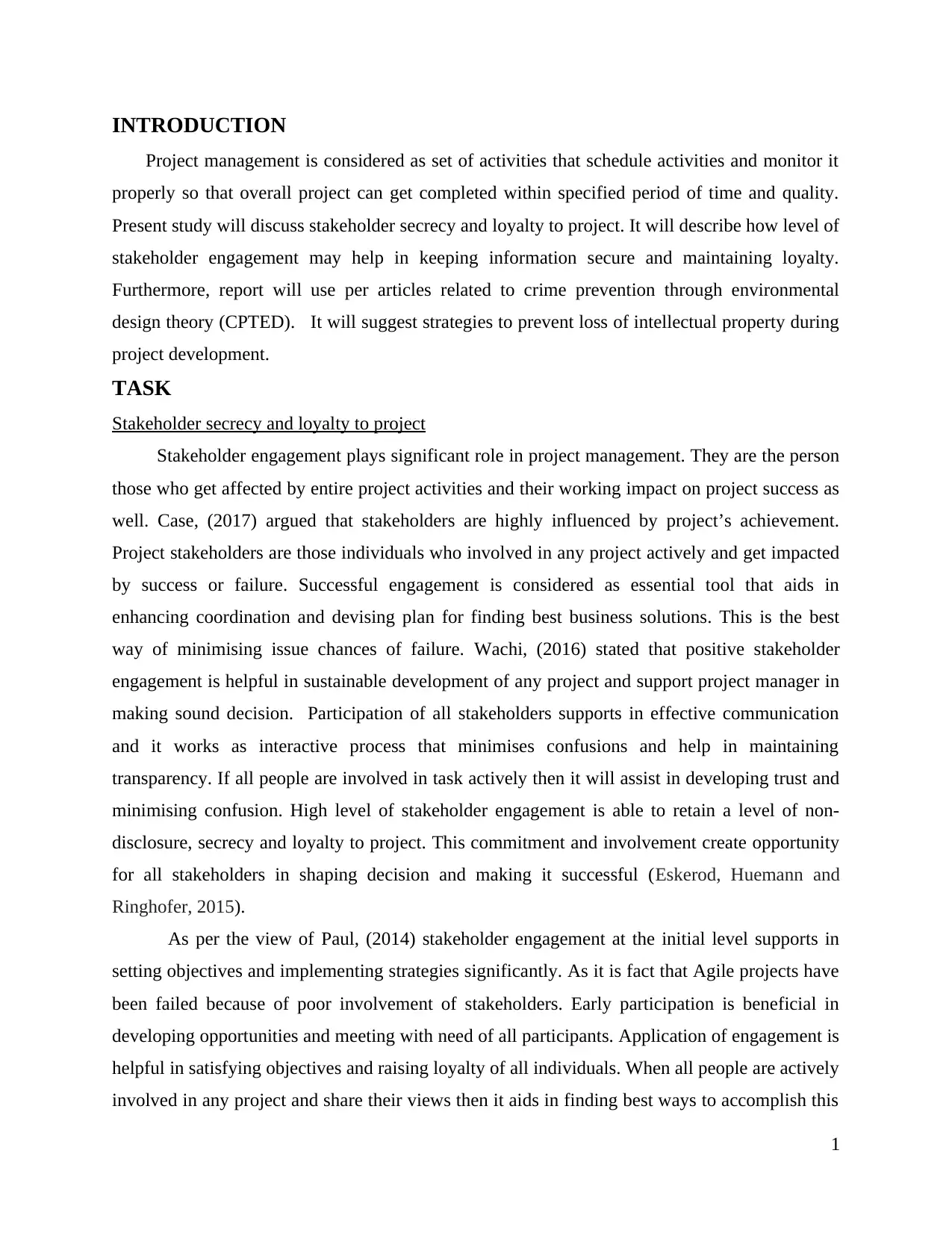
INTRODUCTION
Project management is considered as set of activities that schedule activities and monitor it
properly so that overall project can get completed within specified period of time and quality.
Present study will discuss stakeholder secrecy and loyalty to project. It will describe how level of
stakeholder engagement may help in keeping information secure and maintaining loyalty.
Furthermore, report will use per articles related to crime prevention through environmental
design theory (CPTED). It will suggest strategies to prevent loss of intellectual property during
project development.
TASK
Stakeholder secrecy and loyalty to project
Stakeholder engagement plays significant role in project management. They are the person
those who get affected by entire project activities and their working impact on project success as
well. Case, (2017) argued that stakeholders are highly influenced by project’s achievement.
Project stakeholders are those individuals who involved in any project actively and get impacted
by success or failure. Successful engagement is considered as essential tool that aids in
enhancing coordination and devising plan for finding best business solutions. This is the best
way of minimising issue chances of failure. Wachi, (2016) stated that positive stakeholder
engagement is helpful in sustainable development of any project and support project manager in
making sound decision. Participation of all stakeholders supports in effective communication
and it works as interactive process that minimises confusions and help in maintaining
transparency. If all people are involved in task actively then it will assist in developing trust and
minimising confusion. High level of stakeholder engagement is able to retain a level of non-
disclosure, secrecy and loyalty to project. This commitment and involvement create opportunity
for all stakeholders in shaping decision and making it successful (Eskerod, Huemann and
Ringhofer, 2015).
As per the view of Paul, (2014) stakeholder engagement at the initial level supports in
setting objectives and implementing strategies significantly. As it is fact that Agile projects have
been failed because of poor involvement of stakeholders. Early participation is beneficial in
developing opportunities and meeting with need of all participants. Application of engagement is
helpful in satisfying objectives and raising loyalty of all individuals. When all people are actively
involved in any project and share their views then it aids in finding best ways to accomplish this
1
Project management is considered as set of activities that schedule activities and monitor it
properly so that overall project can get completed within specified period of time and quality.
Present study will discuss stakeholder secrecy and loyalty to project. It will describe how level of
stakeholder engagement may help in keeping information secure and maintaining loyalty.
Furthermore, report will use per articles related to crime prevention through environmental
design theory (CPTED). It will suggest strategies to prevent loss of intellectual property during
project development.
TASK
Stakeholder secrecy and loyalty to project
Stakeholder engagement plays significant role in project management. They are the person
those who get affected by entire project activities and their working impact on project success as
well. Case, (2017) argued that stakeholders are highly influenced by project’s achievement.
Project stakeholders are those individuals who involved in any project actively and get impacted
by success or failure. Successful engagement is considered as essential tool that aids in
enhancing coordination and devising plan for finding best business solutions. This is the best
way of minimising issue chances of failure. Wachi, (2016) stated that positive stakeholder
engagement is helpful in sustainable development of any project and support project manager in
making sound decision. Participation of all stakeholders supports in effective communication
and it works as interactive process that minimises confusions and help in maintaining
transparency. If all people are involved in task actively then it will assist in developing trust and
minimising confusion. High level of stakeholder engagement is able to retain a level of non-
disclosure, secrecy and loyalty to project. This commitment and involvement create opportunity
for all stakeholders in shaping decision and making it successful (Eskerod, Huemann and
Ringhofer, 2015).
As per the view of Paul, (2014) stakeholder engagement at the initial level supports in
setting objectives and implementing strategies significantly. As it is fact that Agile projects have
been failed because of poor involvement of stakeholders. Early participation is beneficial in
developing opportunities and meeting with need of all participants. Application of engagement is
helpful in satisfying objectives and raising loyalty of all individuals. When all people are actively
involved in any project and share their views then it aids in finding best ways to accomplish this
1
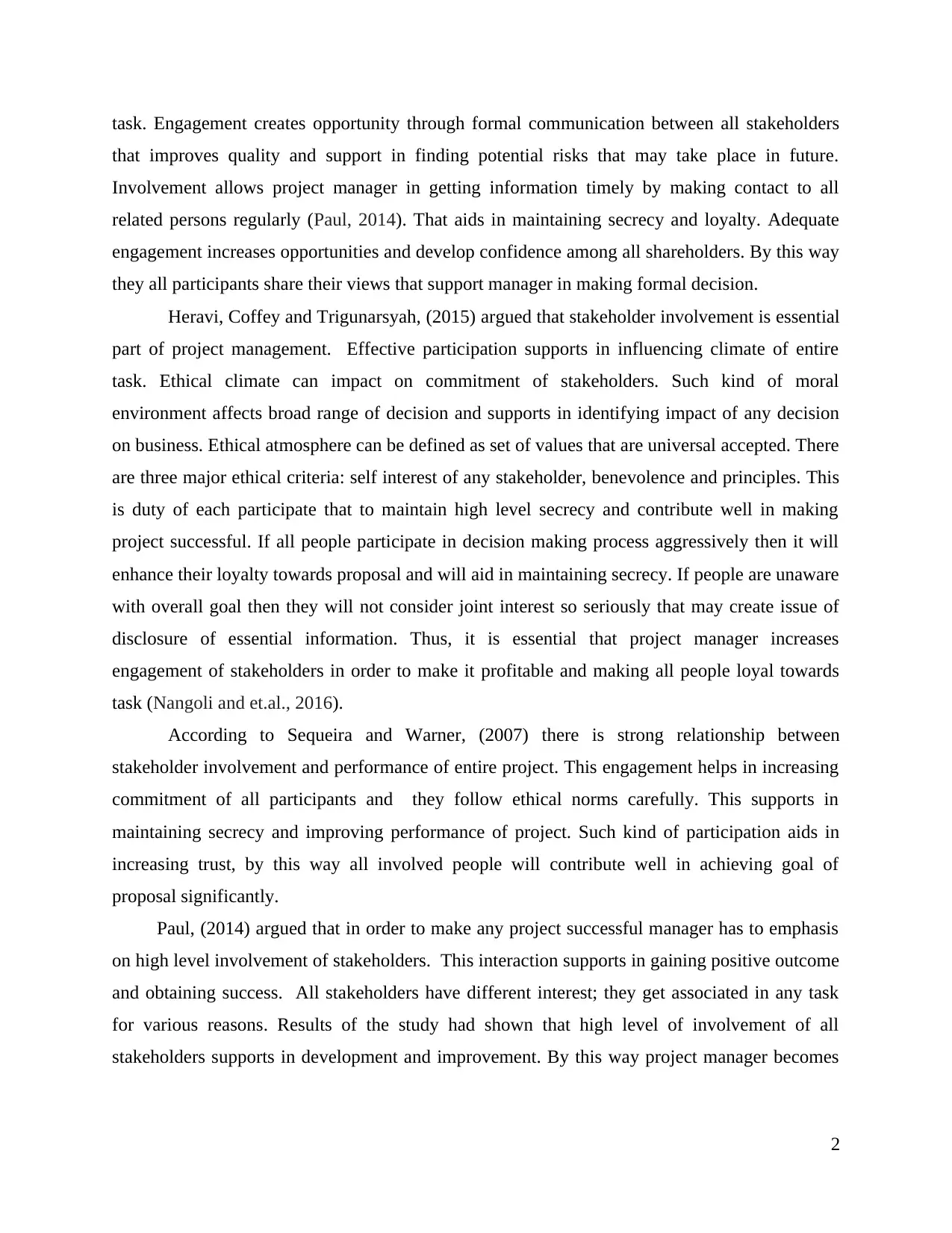
task. Engagement creates opportunity through formal communication between all stakeholders
that improves quality and support in finding potential risks that may take place in future.
Involvement allows project manager in getting information timely by making contact to all
related persons regularly (Paul, 2014). That aids in maintaining secrecy and loyalty. Adequate
engagement increases opportunities and develop confidence among all shareholders. By this way
they all participants share their views that support manager in making formal decision.
Heravi, Coffey and Trigunarsyah, (2015) argued that stakeholder involvement is essential
part of project management. Effective participation supports in influencing climate of entire
task. Ethical climate can impact on commitment of stakeholders. Such kind of moral
environment affects broad range of decision and supports in identifying impact of any decision
on business. Ethical atmosphere can be defined as set of values that are universal accepted. There
are three major ethical criteria: self interest of any stakeholder, benevolence and principles. This
is duty of each participate that to maintain high level secrecy and contribute well in making
project successful. If all people participate in decision making process aggressively then it will
enhance their loyalty towards proposal and will aid in maintaining secrecy. If people are unaware
with overall goal then they will not consider joint interest so seriously that may create issue of
disclosure of essential information. Thus, it is essential that project manager increases
engagement of stakeholders in order to make it profitable and making all people loyal towards
task (Nangoli and et.al., 2016).
According to Sequeira and Warner, (2007) there is strong relationship between
stakeholder involvement and performance of entire project. This engagement helps in increasing
commitment of all participants and they follow ethical norms carefully. This supports in
maintaining secrecy and improving performance of project. Such kind of participation aids in
increasing trust, by this way all involved people will contribute well in achieving goal of
proposal significantly.
Paul, (2014) argued that in order to make any project successful manager has to emphasis
on high level involvement of stakeholders. This interaction supports in gaining positive outcome
and obtaining success. All stakeholders have different interest; they get associated in any task
for various reasons. Results of the study had shown that high level of involvement of all
stakeholders supports in development and improvement. By this way project manager becomes
2
that improves quality and support in finding potential risks that may take place in future.
Involvement allows project manager in getting information timely by making contact to all
related persons regularly (Paul, 2014). That aids in maintaining secrecy and loyalty. Adequate
engagement increases opportunities and develop confidence among all shareholders. By this way
they all participants share their views that support manager in making formal decision.
Heravi, Coffey and Trigunarsyah, (2015) argued that stakeholder involvement is essential
part of project management. Effective participation supports in influencing climate of entire
task. Ethical climate can impact on commitment of stakeholders. Such kind of moral
environment affects broad range of decision and supports in identifying impact of any decision
on business. Ethical atmosphere can be defined as set of values that are universal accepted. There
are three major ethical criteria: self interest of any stakeholder, benevolence and principles. This
is duty of each participate that to maintain high level secrecy and contribute well in making
project successful. If all people participate in decision making process aggressively then it will
enhance their loyalty towards proposal and will aid in maintaining secrecy. If people are unaware
with overall goal then they will not consider joint interest so seriously that may create issue of
disclosure of essential information. Thus, it is essential that project manager increases
engagement of stakeholders in order to make it profitable and making all people loyal towards
task (Nangoli and et.al., 2016).
According to Sequeira and Warner, (2007) there is strong relationship between
stakeholder involvement and performance of entire project. This engagement helps in increasing
commitment of all participants and they follow ethical norms carefully. This supports in
maintaining secrecy and improving performance of project. Such kind of participation aids in
increasing trust, by this way all involved people will contribute well in achieving goal of
proposal significantly.
Paul, (2014) argued that in order to make any project successful manager has to emphasis
on high level involvement of stakeholders. This interaction supports in gaining positive outcome
and obtaining success. All stakeholders have different interest; they get associated in any task
for various reasons. Results of the study had shown that high level of involvement of all
stakeholders supports in development and improvement. By this way project manager becomes
2
Secure Best Marks with AI Grader
Need help grading? Try our AI Grader for instant feedback on your assignments.
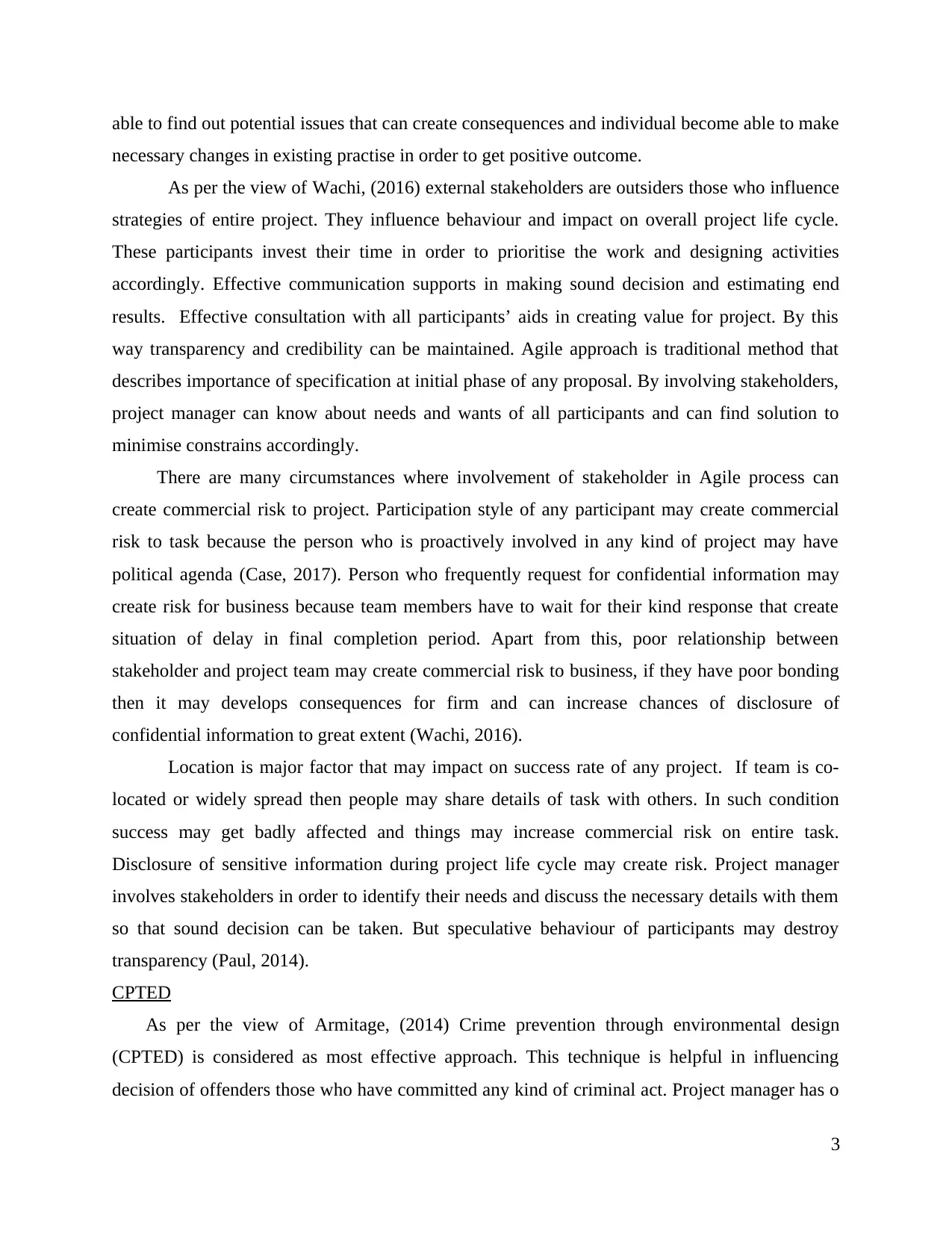
able to find out potential issues that can create consequences and individual become able to make
necessary changes in existing practise in order to get positive outcome.
As per the view of Wachi, (2016) external stakeholders are outsiders those who influence
strategies of entire project. They influence behaviour and impact on overall project life cycle.
These participants invest their time in order to prioritise the work and designing activities
accordingly. Effective communication supports in making sound decision and estimating end
results. Effective consultation with all participants’ aids in creating value for project. By this
way transparency and credibility can be maintained. Agile approach is traditional method that
describes importance of specification at initial phase of any proposal. By involving stakeholders,
project manager can know about needs and wants of all participants and can find solution to
minimise constrains accordingly.
There are many circumstances where involvement of stakeholder in Agile process can
create commercial risk to project. Participation style of any participant may create commercial
risk to task because the person who is proactively involved in any kind of project may have
political agenda (Case, 2017). Person who frequently request for confidential information may
create risk for business because team members have to wait for their kind response that create
situation of delay in final completion period. Apart from this, poor relationship between
stakeholder and project team may create commercial risk to business, if they have poor bonding
then it may develops consequences for firm and can increase chances of disclosure of
confidential information to great extent (Wachi, 2016).
Location is major factor that may impact on success rate of any project. If team is co-
located or widely spread then people may share details of task with others. In such condition
success may get badly affected and things may increase commercial risk on entire task.
Disclosure of sensitive information during project life cycle may create risk. Project manager
involves stakeholders in order to identify their needs and discuss the necessary details with them
so that sound decision can be taken. But speculative behaviour of participants may destroy
transparency (Paul, 2014).
CPTED
As per the view of Armitage, (2014) Crime prevention through environmental design
(CPTED) is considered as most effective approach. This technique is helpful in influencing
decision of offenders those who have committed any kind of criminal act. Project manager has o
3
necessary changes in existing practise in order to get positive outcome.
As per the view of Wachi, (2016) external stakeholders are outsiders those who influence
strategies of entire project. They influence behaviour and impact on overall project life cycle.
These participants invest their time in order to prioritise the work and designing activities
accordingly. Effective communication supports in making sound decision and estimating end
results. Effective consultation with all participants’ aids in creating value for project. By this
way transparency and credibility can be maintained. Agile approach is traditional method that
describes importance of specification at initial phase of any proposal. By involving stakeholders,
project manager can know about needs and wants of all participants and can find solution to
minimise constrains accordingly.
There are many circumstances where involvement of stakeholder in Agile process can
create commercial risk to project. Participation style of any participant may create commercial
risk to task because the person who is proactively involved in any kind of project may have
political agenda (Case, 2017). Person who frequently request for confidential information may
create risk for business because team members have to wait for their kind response that create
situation of delay in final completion period. Apart from this, poor relationship between
stakeholder and project team may create commercial risk to business, if they have poor bonding
then it may develops consequences for firm and can increase chances of disclosure of
confidential information to great extent (Wachi, 2016).
Location is major factor that may impact on success rate of any project. If team is co-
located or widely spread then people may share details of task with others. In such condition
success may get badly affected and things may increase commercial risk on entire task.
Disclosure of sensitive information during project life cycle may create risk. Project manager
involves stakeholders in order to identify their needs and discuss the necessary details with them
so that sound decision can be taken. But speculative behaviour of participants may destroy
transparency (Paul, 2014).
CPTED
As per the view of Armitage, (2014) Crime prevention through environmental design
(CPTED) is considered as most effective approach. This technique is helpful in influencing
decision of offenders those who have committed any kind of criminal act. Project manager has o
3
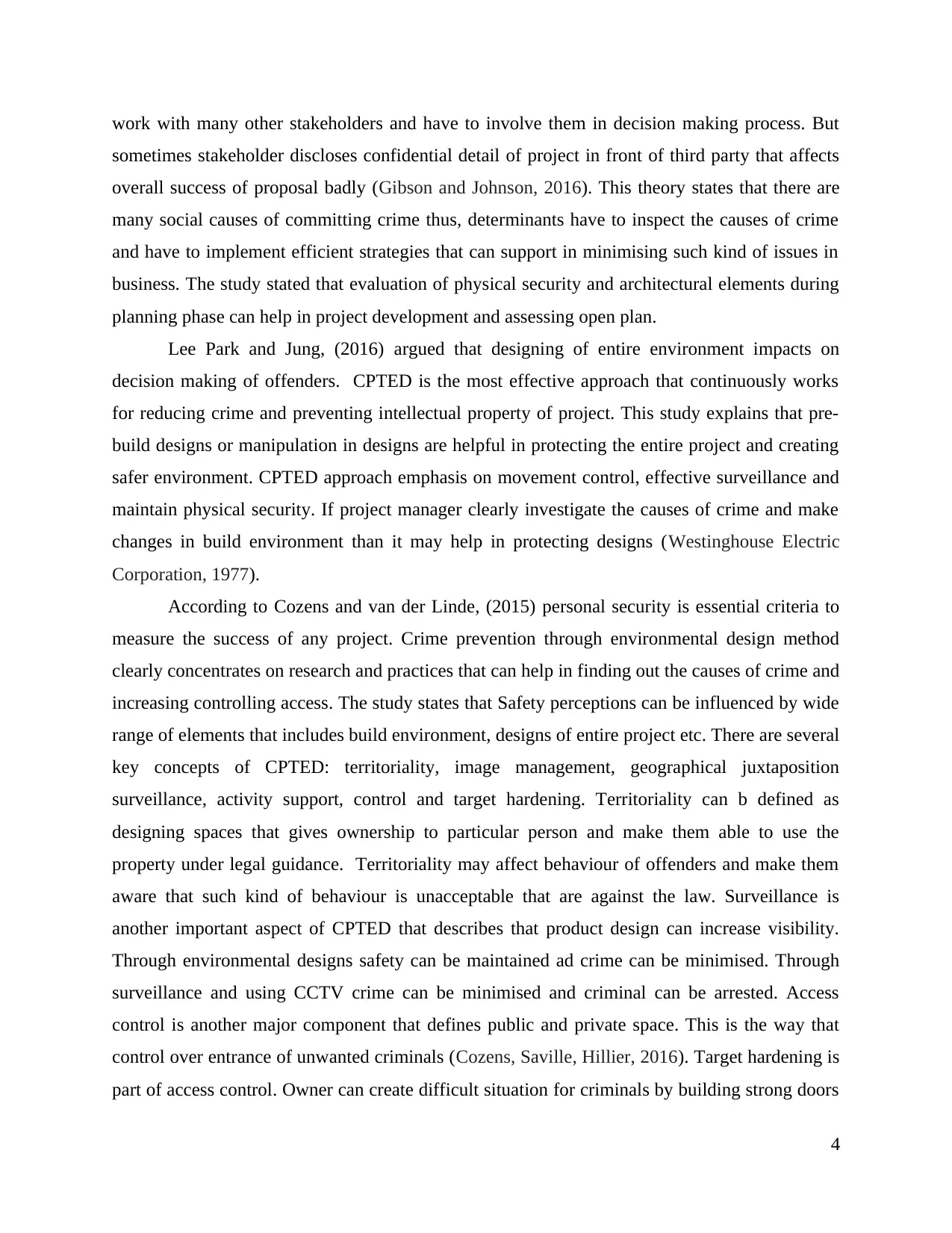
work with many other stakeholders and have to involve them in decision making process. But
sometimes stakeholder discloses confidential detail of project in front of third party that affects
overall success of proposal badly (Gibson and Johnson, 2016). This theory states that there are
many social causes of committing crime thus, determinants have to inspect the causes of crime
and have to implement efficient strategies that can support in minimising such kind of issues in
business. The study stated that evaluation of physical security and architectural elements during
planning phase can help in project development and assessing open plan.
Lee Park and Jung, (2016) argued that designing of entire environment impacts on
decision making of offenders. CPTED is the most effective approach that continuously works
for reducing crime and preventing intellectual property of project. This study explains that pre-
build designs or manipulation in designs are helpful in protecting the entire project and creating
safer environment. CPTED approach emphasis on movement control, effective surveillance and
maintain physical security. If project manager clearly investigate the causes of crime and make
changes in build environment than it may help in protecting designs (Westinghouse Electric
Corporation, 1977).
According to Cozens and van der Linde, (2015) personal security is essential criteria to
measure the success of any project. Crime prevention through environmental design method
clearly concentrates on research and practices that can help in finding out the causes of crime and
increasing controlling access. The study states that Safety perceptions can be influenced by wide
range of elements that includes build environment, designs of entire project etc. There are several
key concepts of CPTED: territoriality, image management, geographical juxtaposition
surveillance, activity support, control and target hardening. Territoriality can b defined as
designing spaces that gives ownership to particular person and make them able to use the
property under legal guidance. Territoriality may affect behaviour of offenders and make them
aware that such kind of behaviour is unacceptable that are against the law. Surveillance is
another important aspect of CPTED that describes that product design can increase visibility.
Through environmental designs safety can be maintained ad crime can be minimised. Through
surveillance and using CCTV crime can be minimised and criminal can be arrested. Access
control is another major component that defines public and private space. This is the way that
control over entrance of unwanted criminals (Cozens, Saville, Hillier, 2016). Target hardening is
part of access control. Owner can create difficult situation for criminals by building strong doors
4
sometimes stakeholder discloses confidential detail of project in front of third party that affects
overall success of proposal badly (Gibson and Johnson, 2016). This theory states that there are
many social causes of committing crime thus, determinants have to inspect the causes of crime
and have to implement efficient strategies that can support in minimising such kind of issues in
business. The study stated that evaluation of physical security and architectural elements during
planning phase can help in project development and assessing open plan.
Lee Park and Jung, (2016) argued that designing of entire environment impacts on
decision making of offenders. CPTED is the most effective approach that continuously works
for reducing crime and preventing intellectual property of project. This study explains that pre-
build designs or manipulation in designs are helpful in protecting the entire project and creating
safer environment. CPTED approach emphasis on movement control, effective surveillance and
maintain physical security. If project manager clearly investigate the causes of crime and make
changes in build environment than it may help in protecting designs (Westinghouse Electric
Corporation, 1977).
According to Cozens and van der Linde, (2015) personal security is essential criteria to
measure the success of any project. Crime prevention through environmental design method
clearly concentrates on research and practices that can help in finding out the causes of crime and
increasing controlling access. The study states that Safety perceptions can be influenced by wide
range of elements that includes build environment, designs of entire project etc. There are several
key concepts of CPTED: territoriality, image management, geographical juxtaposition
surveillance, activity support, control and target hardening. Territoriality can b defined as
designing spaces that gives ownership to particular person and make them able to use the
property under legal guidance. Territoriality may affect behaviour of offenders and make them
aware that such kind of behaviour is unacceptable that are against the law. Surveillance is
another important aspect of CPTED that describes that product design can increase visibility.
Through environmental designs safety can be maintained ad crime can be minimised. Through
surveillance and using CCTV crime can be minimised and criminal can be arrested. Access
control is another major component that defines public and private space. This is the way that
control over entrance of unwanted criminals (Cozens, Saville, Hillier, 2016). Target hardening is
part of access control. Owner can create difficult situation for criminals by building strong doors
4
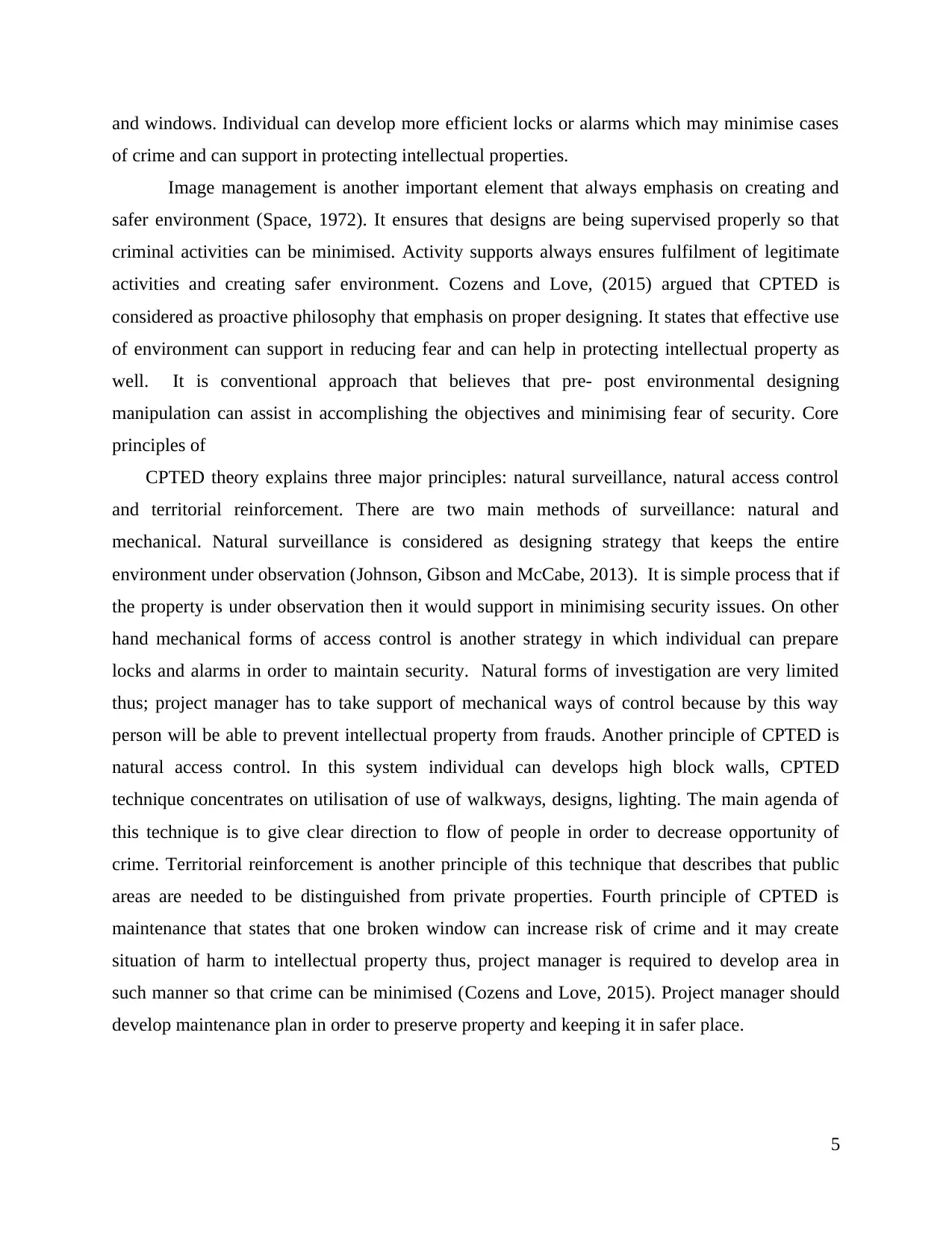
and windows. Individual can develop more efficient locks or alarms which may minimise cases
of crime and can support in protecting intellectual properties.
Image management is another important element that always emphasis on creating and
safer environment (Space, 1972). It ensures that designs are being supervised properly so that
criminal activities can be minimised. Activity supports always ensures fulfilment of legitimate
activities and creating safer environment. Cozens and Love, (2015) argued that CPTED is
considered as proactive philosophy that emphasis on proper designing. It states that effective use
of environment can support in reducing fear and can help in protecting intellectual property as
well. It is conventional approach that believes that pre- post environmental designing
manipulation can assist in accomplishing the objectives and minimising fear of security. Core
principles of
CPTED theory explains three major principles: natural surveillance, natural access control
and territorial reinforcement. There are two main methods of surveillance: natural and
mechanical. Natural surveillance is considered as designing strategy that keeps the entire
environment under observation (Johnson, Gibson and McCabe, 2013). It is simple process that if
the property is under observation then it would support in minimising security issues. On other
hand mechanical forms of access control is another strategy in which individual can prepare
locks and alarms in order to maintain security. Natural forms of investigation are very limited
thus; project manager has to take support of mechanical ways of control because by this way
person will be able to prevent intellectual property from frauds. Another principle of CPTED is
natural access control. In this system individual can develops high block walls, CPTED
technique concentrates on utilisation of use of walkways, designs, lighting. The main agenda of
this technique is to give clear direction to flow of people in order to decrease opportunity of
crime. Territorial reinforcement is another principle of this technique that describes that public
areas are needed to be distinguished from private properties. Fourth principle of CPTED is
maintenance that states that one broken window can increase risk of crime and it may create
situation of harm to intellectual property thus, project manager is required to develop area in
such manner so that crime can be minimised (Cozens and Love, 2015). Project manager should
develop maintenance plan in order to preserve property and keeping it in safer place.
5
of crime and can support in protecting intellectual properties.
Image management is another important element that always emphasis on creating and
safer environment (Space, 1972). It ensures that designs are being supervised properly so that
criminal activities can be minimised. Activity supports always ensures fulfilment of legitimate
activities and creating safer environment. Cozens and Love, (2015) argued that CPTED is
considered as proactive philosophy that emphasis on proper designing. It states that effective use
of environment can support in reducing fear and can help in protecting intellectual property as
well. It is conventional approach that believes that pre- post environmental designing
manipulation can assist in accomplishing the objectives and minimising fear of security. Core
principles of
CPTED theory explains three major principles: natural surveillance, natural access control
and territorial reinforcement. There are two main methods of surveillance: natural and
mechanical. Natural surveillance is considered as designing strategy that keeps the entire
environment under observation (Johnson, Gibson and McCabe, 2013). It is simple process that if
the property is under observation then it would support in minimising security issues. On other
hand mechanical forms of access control is another strategy in which individual can prepare
locks and alarms in order to maintain security. Natural forms of investigation are very limited
thus; project manager has to take support of mechanical ways of control because by this way
person will be able to prevent intellectual property from frauds. Another principle of CPTED is
natural access control. In this system individual can develops high block walls, CPTED
technique concentrates on utilisation of use of walkways, designs, lighting. The main agenda of
this technique is to give clear direction to flow of people in order to decrease opportunity of
crime. Territorial reinforcement is another principle of this technique that describes that public
areas are needed to be distinguished from private properties. Fourth principle of CPTED is
maintenance that states that one broken window can increase risk of crime and it may create
situation of harm to intellectual property thus, project manager is required to develop area in
such manner so that crime can be minimised (Cozens and Love, 2015). Project manager should
develop maintenance plan in order to preserve property and keeping it in safer place.
5
Paraphrase This Document
Need a fresh take? Get an instant paraphrase of this document with our AI Paraphraser
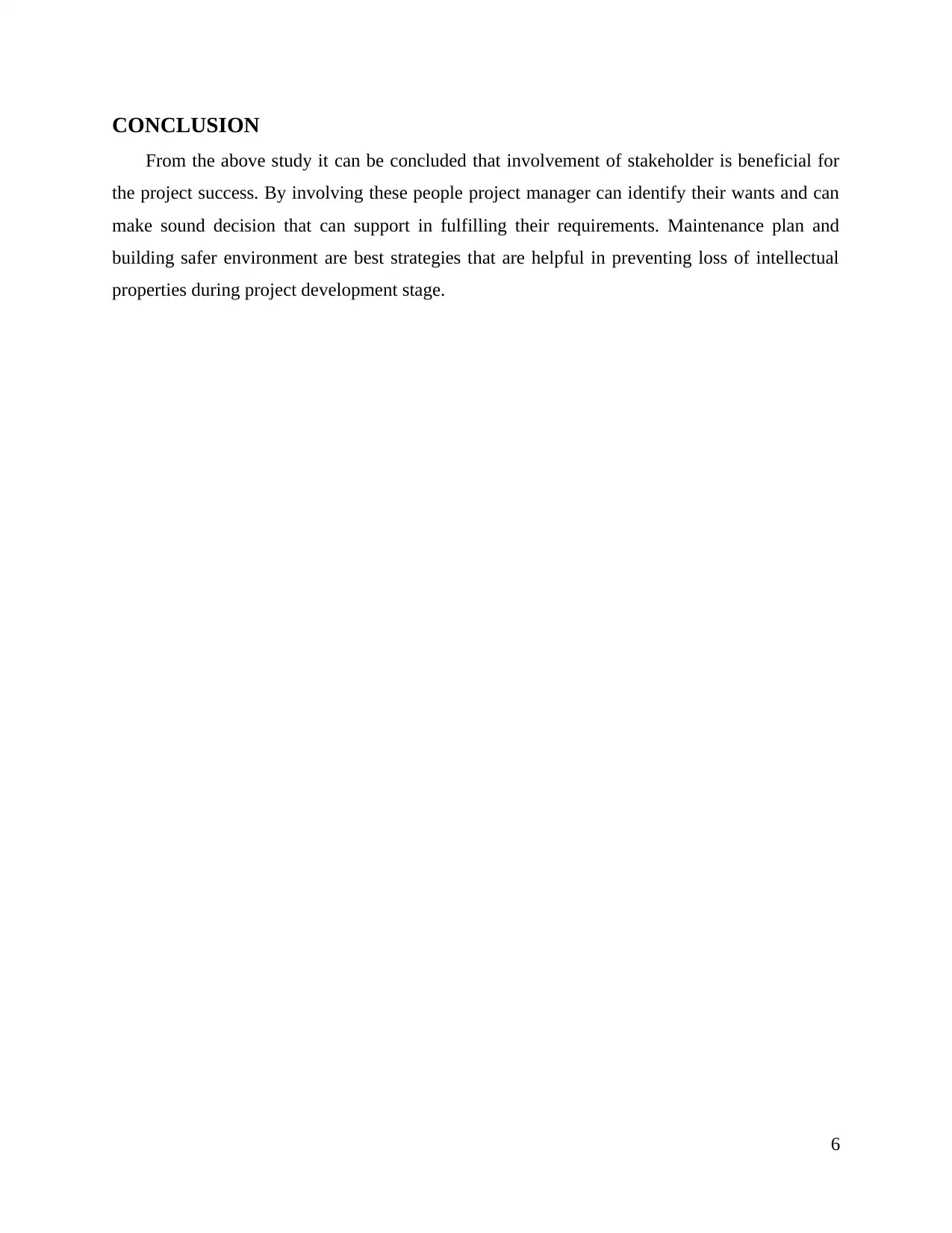
CONCLUSION
From the above study it can be concluded that involvement of stakeholder is beneficial for
the project success. By involving these people project manager can identify their wants and can
make sound decision that can support in fulfilling their requirements. Maintenance plan and
building safer environment are best strategies that are helpful in preventing loss of intellectual
properties during project development stage.
6
From the above study it can be concluded that involvement of stakeholder is beneficial for
the project success. By involving these people project manager can identify their wants and can
make sound decision that can support in fulfilling their requirements. Maintenance plan and
building safer environment are best strategies that are helpful in preventing loss of intellectual
properties during project development stage.
6
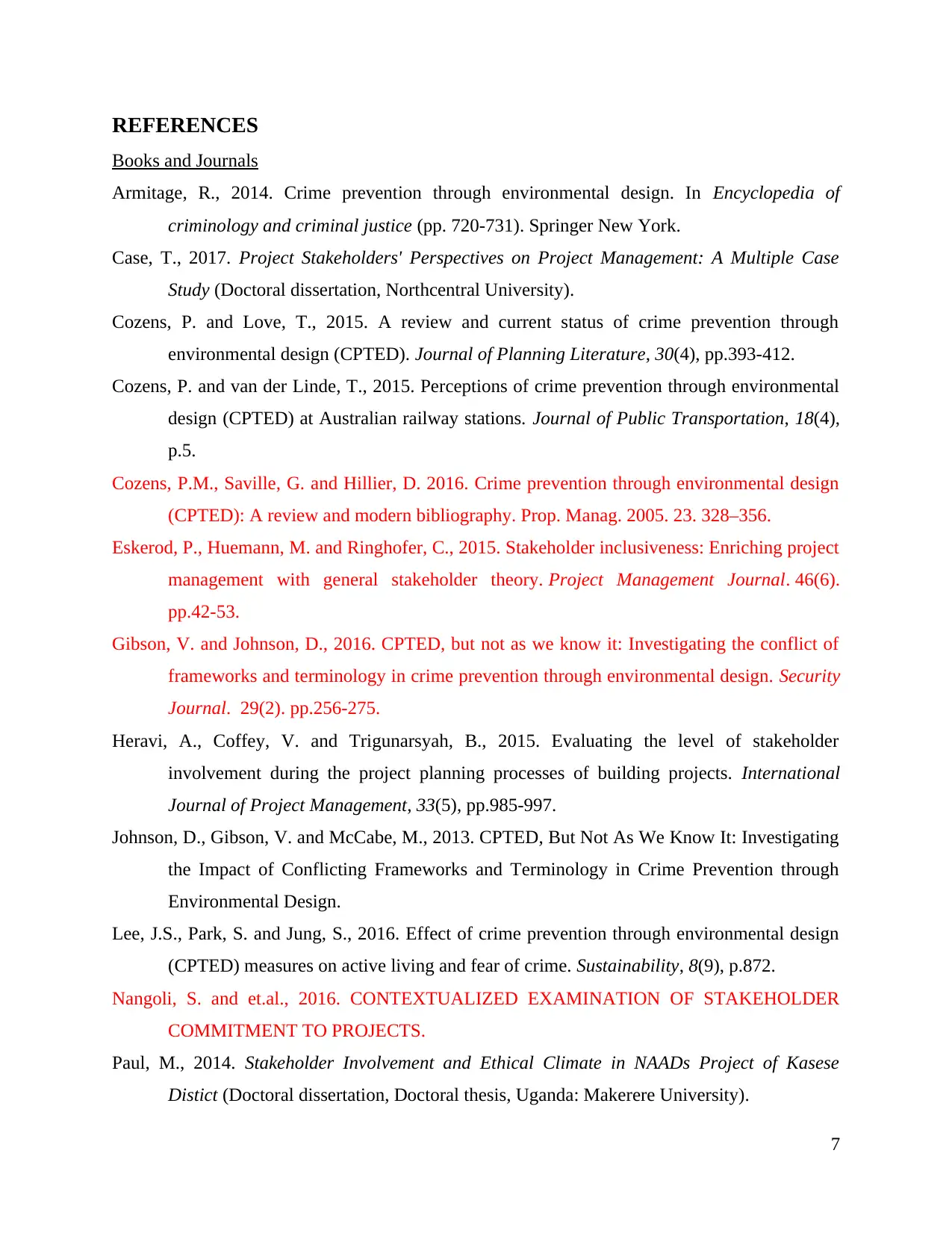
REFERENCES
Books and Journals
Armitage, R., 2014. Crime prevention through environmental design. In Encyclopedia of
criminology and criminal justice (pp. 720-731). Springer New York.
Case, T., 2017. Project Stakeholders' Perspectives on Project Management: A Multiple Case
Study (Doctoral dissertation, Northcentral University).
Cozens, P. and Love, T., 2015. A review and current status of crime prevention through
environmental design (CPTED). Journal of Planning Literature, 30(4), pp.393-412.
Cozens, P. and van der Linde, T., 2015. Perceptions of crime prevention through environmental
design (CPTED) at Australian railway stations. Journal of Public Transportation, 18(4),
p.5.
Cozens, P.M., Saville, G. and Hillier, D. 2016. Crime prevention through environmental design
(CPTED): A review and modern bibliography. Prop. Manag. 2005. 23. 328–356.
Eskerod, P., Huemann, M. and Ringhofer, C., 2015. Stakeholder inclusiveness: Enriching project
management with general stakeholder theory. Project Management Journal. 46(6).
pp.42-53.
Gibson, V. and Johnson, D., 2016. CPTED, but not as we know it: Investigating the conflict of
frameworks and terminology in crime prevention through environmental design. Security
Journal. 29(2). pp.256-275.
Heravi, A., Coffey, V. and Trigunarsyah, B., 2015. Evaluating the level of stakeholder
involvement during the project planning processes of building projects. International
Journal of Project Management, 33(5), pp.985-997.
Johnson, D., Gibson, V. and McCabe, M., 2013. CPTED, But Not As We Know It: Investigating
the Impact of Conflicting Frameworks and Terminology in Crime Prevention through
Environmental Design.
Lee, J.S., Park, S. and Jung, S., 2016. Effect of crime prevention through environmental design
(CPTED) measures on active living and fear of crime. Sustainability, 8(9), p.872.
Nangoli, S. and et.al., 2016. CONTEXTUALIZED EXAMINATION OF STAKEHOLDER
COMMITMENT TO PROJECTS.
Paul, M., 2014. Stakeholder Involvement and Ethical Climate in NAADs Project of Kasese
Distict (Doctoral dissertation, Doctoral thesis, Uganda: Makerere University).
7
Books and Journals
Armitage, R., 2014. Crime prevention through environmental design. In Encyclopedia of
criminology and criminal justice (pp. 720-731). Springer New York.
Case, T., 2017. Project Stakeholders' Perspectives on Project Management: A Multiple Case
Study (Doctoral dissertation, Northcentral University).
Cozens, P. and Love, T., 2015. A review and current status of crime prevention through
environmental design (CPTED). Journal of Planning Literature, 30(4), pp.393-412.
Cozens, P. and van der Linde, T., 2015. Perceptions of crime prevention through environmental
design (CPTED) at Australian railway stations. Journal of Public Transportation, 18(4),
p.5.
Cozens, P.M., Saville, G. and Hillier, D. 2016. Crime prevention through environmental design
(CPTED): A review and modern bibliography. Prop. Manag. 2005. 23. 328–356.
Eskerod, P., Huemann, M. and Ringhofer, C., 2015. Stakeholder inclusiveness: Enriching project
management with general stakeholder theory. Project Management Journal. 46(6).
pp.42-53.
Gibson, V. and Johnson, D., 2016. CPTED, but not as we know it: Investigating the conflict of
frameworks and terminology in crime prevention through environmental design. Security
Journal. 29(2). pp.256-275.
Heravi, A., Coffey, V. and Trigunarsyah, B., 2015. Evaluating the level of stakeholder
involvement during the project planning processes of building projects. International
Journal of Project Management, 33(5), pp.985-997.
Johnson, D., Gibson, V. and McCabe, M., 2013. CPTED, But Not As We Know It: Investigating
the Impact of Conflicting Frameworks and Terminology in Crime Prevention through
Environmental Design.
Lee, J.S., Park, S. and Jung, S., 2016. Effect of crime prevention through environmental design
(CPTED) measures on active living and fear of crime. Sustainability, 8(9), p.872.
Nangoli, S. and et.al., 2016. CONTEXTUALIZED EXAMINATION OF STAKEHOLDER
COMMITMENT TO PROJECTS.
Paul, M., 2014. Stakeholder Involvement and Ethical Climate in NAADs Project of Kasese
Distict (Doctoral dissertation, Doctoral thesis, Uganda: Makerere University).
7
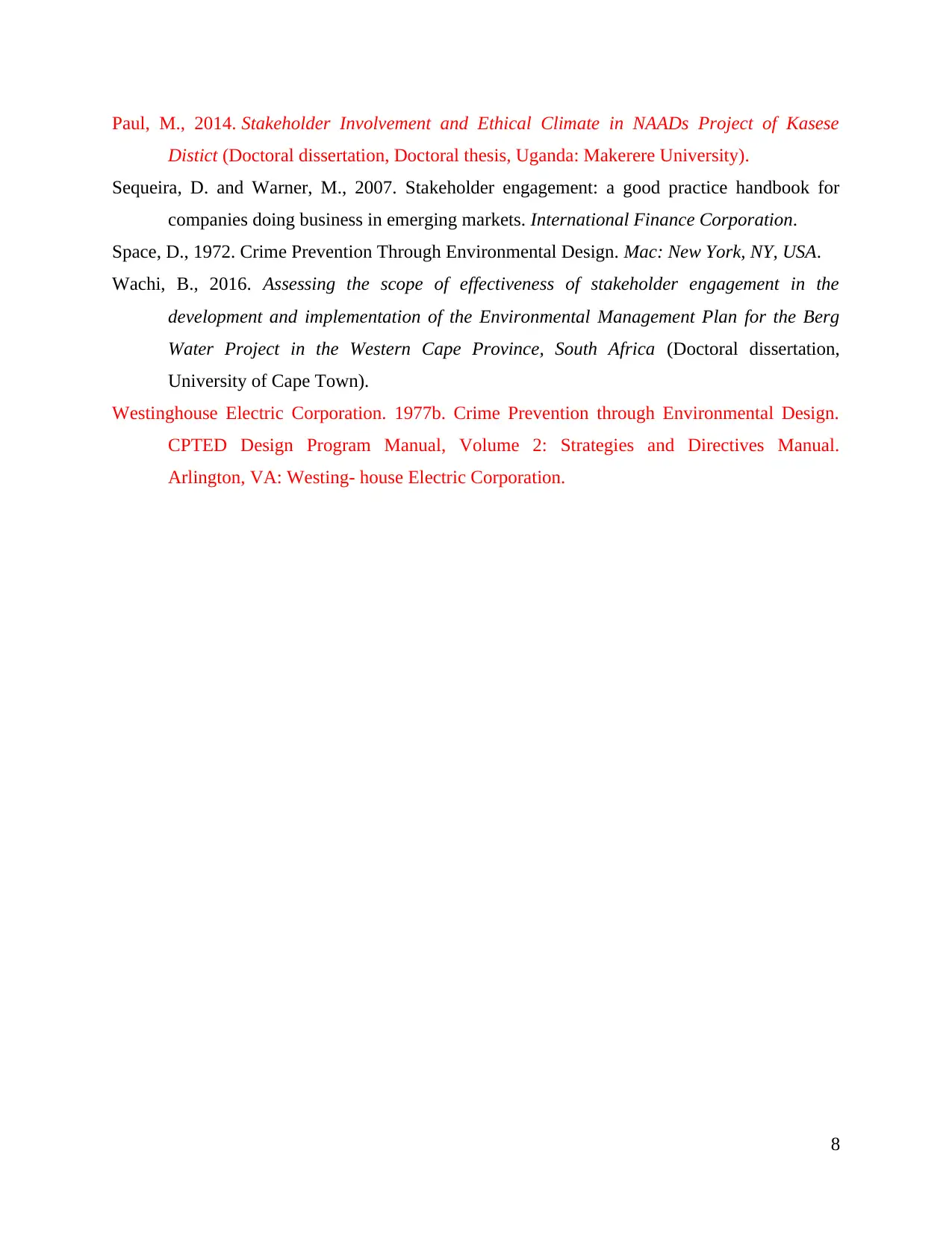
Paul, M., 2014. Stakeholder Involvement and Ethical Climate in NAADs Project of Kasese
Distict (Doctoral dissertation, Doctoral thesis, Uganda: Makerere University).
Sequeira, D. and Warner, M., 2007. Stakeholder engagement: a good practice handbook for
companies doing business in emerging markets. International Finance Corporation.
Space, D., 1972. Crime Prevention Through Environmental Design. Mac: New York, NY, USA.
Wachi, B., 2016. Assessing the scope of effectiveness of stakeholder engagement in the
development and implementation of the Environmental Management Plan for the Berg
Water Project in the Western Cape Province, South Africa (Doctoral dissertation,
University of Cape Town).
Westinghouse Electric Corporation. 1977b. Crime Prevention through Environmental Design.
CPTED Design Program Manual, Volume 2: Strategies and Directives Manual.
Arlington, VA: Westing- house Electric Corporation.
8
Distict (Doctoral dissertation, Doctoral thesis, Uganda: Makerere University).
Sequeira, D. and Warner, M., 2007. Stakeholder engagement: a good practice handbook for
companies doing business in emerging markets. International Finance Corporation.
Space, D., 1972. Crime Prevention Through Environmental Design. Mac: New York, NY, USA.
Wachi, B., 2016. Assessing the scope of effectiveness of stakeholder engagement in the
development and implementation of the Environmental Management Plan for the Berg
Water Project in the Western Cape Province, South Africa (Doctoral dissertation,
University of Cape Town).
Westinghouse Electric Corporation. 1977b. Crime Prevention through Environmental Design.
CPTED Design Program Manual, Volume 2: Strategies and Directives Manual.
Arlington, VA: Westing- house Electric Corporation.
8
1 out of 10
Related Documents
Your All-in-One AI-Powered Toolkit for Academic Success.
+13062052269
info@desklib.com
Available 24*7 on WhatsApp / Email
![[object Object]](/_next/static/media/star-bottom.7253800d.svg)
Unlock your academic potential
© 2024 | Zucol Services PVT LTD | All rights reserved.





